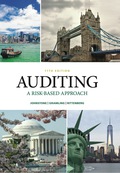
a.
Introduction:Public Company Accounting Oversight Board (PCAOB) lays down the auditing and accounting standards which are to be followed by the public companies. It is a non-profit organization with an aim to safeguard the interests of various stakeholders; especially investors.
To identify:The role of Public Company Accounting Oversight Board (PCAOB) that affects the external
b.
Introduction:Securities and Exchange Commission (SEC) was established in 1934 with the aim to regulate the capital market and its system. The SEC is authorized to establish GAAP standards for publicly traded companies
To identify:The role of Securities and Exchange Commission (SEC) that affects the external auditing process.
c.
Introduction:American Institute of Certified Public Accountants (AICPA) regulates accounting profession within the country and issues codes of professional conduct that are to be followed by the AICPA members.
To identify:The role of AICPA that affects the external auditing process.
d.
Introduction:Centre for Audit Quality (CAQ) is focused on increasing the investors’ confidence in the global stock market.
To identify:The role of CAQ that affects the external auditing process.
e.
Introduction:International
To identify: The role of IAASB that affects the external auditing process.
f.
Introduction:Financial reporting council (FRC) is an independent regulatory body which helps in promoting securities investment through fair and just corporate governance and financial reporting.
To identify:The role of FRC that affects the external auditing process
Want to see the full answer?
Check out a sample textbook solution
Chapter 1 Solutions
EBK AUDITING: A RISK BASED-APPROACH
- Financial accountingarrow_forwardBased on the attached amortization schedule, what is the amount for the interest expense and amortization expense that is missing from the ledger? 2 year term, 8 quarterly payments, 6% rate Initial lease $136768arrow_forwardSouthern Company leased high-tech electronic equipment from Edison Leasing on January 1, 2024. Edison purchased the equipment from International Machines at a cost of $136,768. 2 year lease, with 8 quarterly payments of $18,000 each, 6% interest rate. What is the amortization schedule for this loan starting Jan 1, 2024?arrow_forward
- Questi 8arrow_forwardPrice and Efficiency Variances (22 points) The Livingston Corporation manufactures lamps. It has set up the following standards per finished unit for direct materials and direct manufacturing labor: 「 Direct Materials: 10 lb. at $5.20 per lb. Direct Manufacturing Labor: 0.5 hour at $30 per hour $52 $15.00 The number of finished unit budgeted for January 2017 was 9,940; 9,900 units were actually produced. Actual Results in January 2017 were as follows: 1.200 Direct Materials: 97,500 lb. used Direct Manufacturing Labor: 4,900 hours budg $155,575 During the month, materials purchases amounts to 99,400 lb., at a total cost of $536,760. Input price variances are isolated upon purchase. Input efficiency variances are isolated at the time of usage. Requirement Computer the January 2017 price and efficiency variances of direct materials and direct manufacturing labor. (Put a U for Unfavorable and a F for Favorable variances) 53670 Actual Costs Incurred Costs (Actual Input Qty. Actual Input…arrow_forwardMaple Grove Trading presents the following financial information Description Operating Expenses Amount 60,000 Sales Returns and Allowances 7,000 Sales Discounts Sales Revenue Cost of Goods Sold 10,000 200,000 95,000 What is Maple Grove Trading's gross profit? a. $98,000 b. $85,000 c. $88,000 d. $75,000arrow_forward
 Auditing: A Risk Based-Approach (MindTap Course L...AccountingISBN:9781337619455Author:Karla M Johnstone, Audrey A. Gramling, Larry E. RittenbergPublisher:Cengage Learning
Auditing: A Risk Based-Approach (MindTap Course L...AccountingISBN:9781337619455Author:Karla M Johnstone, Audrey A. Gramling, Larry E. RittenbergPublisher:Cengage Learning Auditing: A Risk Based-Approach to Conducting a Q...AccountingISBN:9781305080577Author:Karla M Johnstone, Audrey A. Gramling, Larry E. RittenbergPublisher:South-Western College Pub
Auditing: A Risk Based-Approach to Conducting a Q...AccountingISBN:9781305080577Author:Karla M Johnstone, Audrey A. Gramling, Larry E. RittenbergPublisher:South-Western College Pub Financial Accounting: The Impact on Decision Make...AccountingISBN:9781305654174Author:Gary A. Porter, Curtis L. NortonPublisher:Cengage Learning
Financial Accounting: The Impact on Decision Make...AccountingISBN:9781305654174Author:Gary A. Porter, Curtis L. NortonPublisher:Cengage Learning- Principles of Accounting Volume 2AccountingISBN:9781947172609Author:OpenStaxPublisher:OpenStax College




